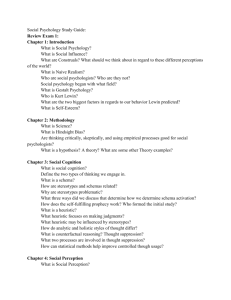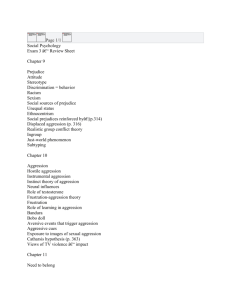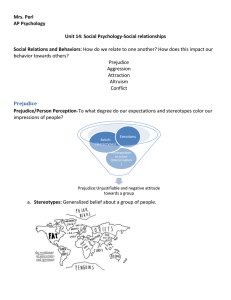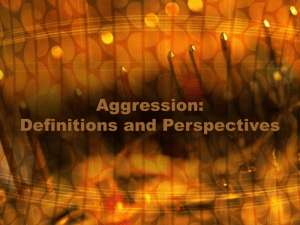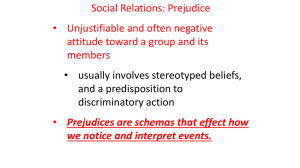Welcome to Social Psychology: Lecture #1 topics
advertisement
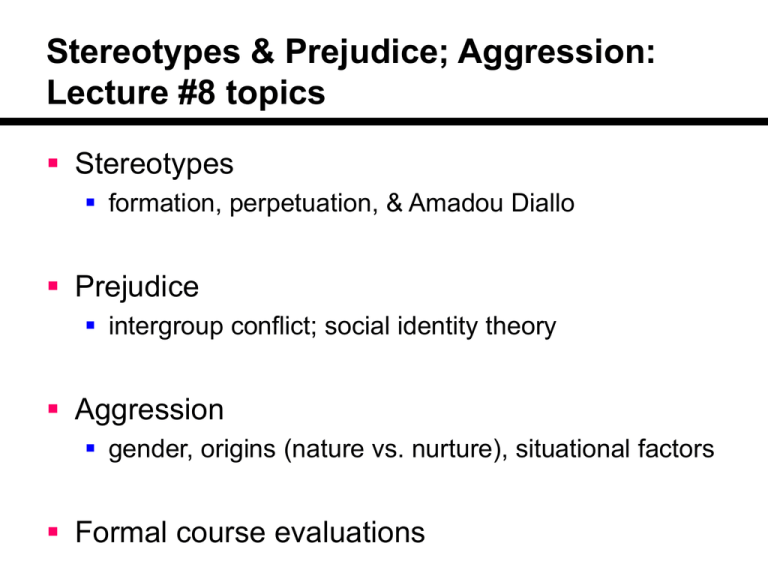
Stereotypes & Prejudice; Aggression: Lecture #8 topics Stereotypes formation, perpetuation, & Amadou Diallo Prejudice intergroup conflict; social identity theory Aggression gender, origins (nature vs. nurture), situational factors Formal course evaluations Stereotypes “41 SHOTS” 41 shots cut through the night You’re kneeling over his body in a vestibule Praying for his life. Is it a gun, is it a knife Is it a wallet, this is your life It ain’t no secret, no secret my friend You can get killed for living in your American skin. —Bruce Springsteen Stereotypes Amadou Diallo Stereotypes stereotypes: beliefs that associate an entire group of people with certain traits athletes are stupid librarians are quiet Italians are emotional White men can’t jump Koreans own convenience stores/ drycleaners Stereotypes STEREOTYPE FORMATION Stereotypes social categorization: classifying individuals into groups based on _______ _______ Stereotypes Benefits lets us form inferences about people efficiently Drawbacks _______ of _______ differences; _______ of _______ differences failure to perceive _______ - _______ information belief that intergroup differences are more _______ than they really are Stereotypes when we distinguish in-groups vs. out-groups: _______ of intergroup differences may have had adaptive significance over evolution outgroup _______ effect assumption that there is more _______ among outgroup members than among in-group members _______ leads to perception that out-group members all look the same (e.g., East Asians) Stereotypes www.alllooksame.com: my score: 8/ 18 “needs a lot more work” Stereotypes what accounts for out-group homogeneity? _______ _______ with out-groups in-group members are seen as _______; out-group members are seen more _______ _______ samples of out-groups obnoxious U of T students at football game do NOT represent ALL U of T students Stereotypes fundamental attribution error: overestimation of personal & underestimation of situational factors when explaining other people’s behaviour e.g., _______ _______ : we don’t take into account that underperformance is due to _______, not personal ability; thus, our stereotypes get confirmed Stereotypes Billie Jean King & Bobby Riggs stereotype-disconfirming acts are explained by _______ situational factors & _______ personal factors e.g., Billie Jean won because of luck, not skill Stereotypes confirmation bias: tendency to interpret & seek information that confirms our expectations we interpret _______ behaviours to be _______ with stereotypes e.g., an ambiguously aggressive behaviour will be seen as more threatening when actor is Black rather than White Stereotypes Stone (1997): Ratings of player HIGH Court smarts Athletic ability LOW Player is White Player is Black Stereotypes self-fulfilling prophesies: when our expectations about someone cause him/ her to act in ways that confirm our expectations e.g., Word (1974): White interviewers’ demeanour elicited _______ performance from Black applicants, which confirmed stereotypes Stereotypes Payne (2001): TASK: Is object a weapon? _______ _______ _______ _______ _______ _______ Stereotypes Correll (2002): _______ _______ GUN: “SHOOT” CELL PHONE: “DON’T SHOOT” GUN: “SHOOT” CELL PHONE: “DON’T SHOOT” Stereotypes RESULTS: ARMED TARGET UNARMED TARGET _________________________ _________________________ _________________________ Prejudice Sherif’s (1954) Robbers Cave study: boys formed in-groups groups went to war groups made peace Prejudice Tajfel’s (1971) minimal groups paradigm: participants divided into “_______” & “_______” created _______ _______: categorizing people into groups according to _______ similarities participants awarded more points to people in their own groups than to people in the other group in-group bias: favouring your _______ over _______ Prejudice social identity theory (Tajfel, 1982; Turner, 1987): we’re motivated to enhance self-esteem, which consists of: _______ self-esteem: based on personal identity _______ self-esteem: based on social identity we enhance self-esteem by: _______ achievements, or connecting ourselves with _______ groups Prejudice basic predictions: if our self-esteem is _______ , in-group favouritism will _______ when we _______ our in-groups, our selfesteem will _______ Prejudice Fein & Spencer (1997): Ratings of applicants HIGH Positive feedback Negative feedback LOW Italian applicant Jewish applicant Prejudice Fein & Spencer (1997): Increase in self-esteem HIGH Positive feedback Negative feedback LOW Italian applicant Jewish applicant Aggression BEHAVIOUR accidentally hurting someone working hard to make a sale biting someone on the neck swinging a stick at someone but missing insulting someone deliberately failing to stop harm murdering for $$ hiring someone to break someone’s kneecaps hitting others while enraged AGGRESSIVE? Aggression aggression: behaviours intended to harm another individual In the U.S. in 2002, there was, on average: One MURDER One RAPE One AGGRAVATED ASSAULT One VIOLENT CRIME …every 32 minutes …every 6 minutes …every 35 seconds …every 22 seconds Aggression ORIGINS OF AGGRESSION instinct theories: Freud: aggression = _______ of life over death instinct Lorenz: aggression enhances _______ survival evolutionary perspectives: aggression enhances _______ survival adaptive to not aggress against _______ _______ adaptive for males to aggress to ensure _______ adaptive for females to aggress to _______ _______ Aggression biological perspectives: role of testosterone: _______ transsexuals experience _______ aggression _______ transsexuals experience _______ aggression role of serotonin (5-HT): helps decrease _______ low 5-HT related to higher aggression; drugs (SSRIs) that _______ 5-HT activity related to _______ aggression Aggression learning perspectives: aggression is _______ reinforcing a child who hits to get a toy will be more likely to hit again aggression is _______ reinforcing a child who shoves to stop teasing will be more likely to shove again Aggression using punishment to stop aggression can backfire: spanking gives kids a role model to imitate – can encourage aggression corporal punishment is related to childhood & adult aggression & to adult criminal behaviour Aggression social learning theory (Bandura, 1977): we learn from _______’ examples & from _______ experience with rewards & punishment _______ influence whether we help or harm the Bobo doll study (1961) watching an _______ model led kids to _______ they _______ their aggression to the model (they punched when she punched & kicked when she kicked) Aggression SITUATIONAL INFLUENCES frustration-aggression hypothesis (Dollard, 1939): _______ progress toward a goal causes _______, eliciting motivation to aggress all aggression is caused by _______ Aggression we _______ our aggression when we can’t aggress against source of frustration we deflect it from real target onto a substitute aggression is _______ motivation to aggress drops when we imagine, observe, or act out aggression this reduces physiological arousal, which decreases anger & likelihood of aggressing Aggression evidence does not support aggression as cathartic: imagining/ seeing aggressive models _______ arousal if aggression feels _______ because it decreases arousal, chances of future aggression increase anger may _______ if we blow off steam Aggression SITUATIONAL INFLUENCES heat: higher incidence of violent crimes during summer during hotter years in hotter cities Aggression ML pitchers more likely to hit batters when it’s hot: HBPs per game HIGH LOW <21°C 21-26°C 27-32°C 33+°C

